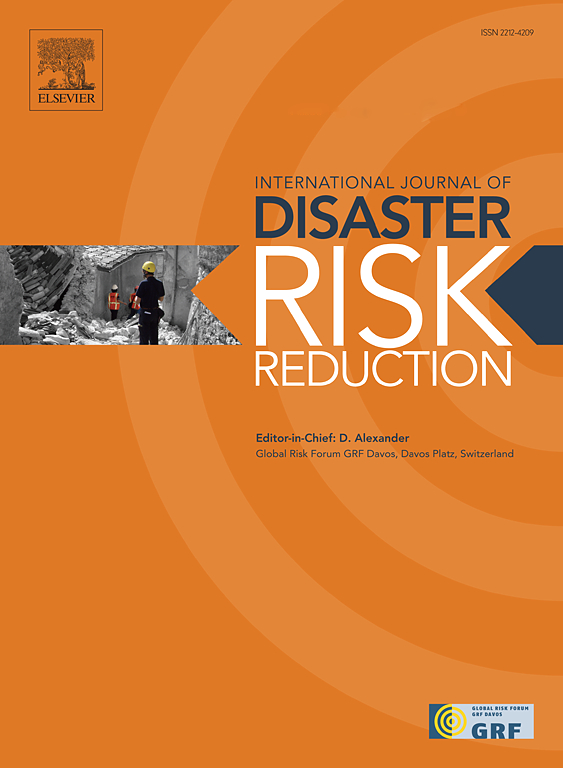Flood-ABM: An agent-based model of differential flood effects on population groups and their decision-making processes
IF 4.2
1区 地球科学
Q1 GEOSCIENCES, MULTIDISCIPLINARY
International journal of disaster risk reduction
Pub Date : 2025-07-23
DOI:10.1016/j.ijdrr.2025.105698
引用次数: 0
Abstract
Flooding is a global concern with wide-ranging impacts on communities, infrastructure, and ecosystems. Its effects are often unevenly distributed, influenced by complex interactions between environmental and social systems. In this paper, we present an agent-based model (ABM) that links hydrological and social systems through a differentiating lens. Our ABM captures individual and collective behaviors across pre-flood, during-flood, and post-flood phases, while differentiating population groups through a socio-economic index to examine how disparities in resources and vulnerability influence decisions related to preparedness, evacuation, coping, and adaptation. Our model innovatively integrates four decision-making theories—Protection Motivation Theory, the Theory of Planned Behavior, Cultural Risk Theory, and Social Capital Theory—in a complex framework that reflects diverse individuals strategies during floods. We find that agents facing intense flood threats respond rapidly with emergency measures—such as swift evacuations and immediate protective actions—even when constrained by resource limitations. In contrast, agents in less critical scenarios exhibit more measured responses, engaging in thorough pre-event planning and gradual evacuations that facilitate smoother adaptations post-flood. Economic impacts quantified by the model demonstrate that widespread business closures significantly reduce earnings, while increased spending on healthcare and evacuation drives up overall costs. During peak flooding, shelter agents suffer wealth declines due to the high costs of providing emergency services, and healthcare agent resources are strained by surging demand as health deteriorates among affected populations. Our results indicate that increased shelter capacity, expedited rescue responses, and enhanced healthcare provision collectively promote post-flood economic stabilization by reducing stranded individuals and mitigating peak-phase financial losses.
洪水- abm:基于agent的洪水对不同人群及其决策过程的影响模型
洪水是一个全球性问题,对社区、基础设施和生态系统产生广泛影响。其影响往往分布不均,受到环境和社会系统之间复杂相互作用的影响。在本文中,我们提出了一种基于主体的模型(ABM),该模型通过区分透镜将水文系统和社会系统联系起来。我们的ABM捕获了洪水前、洪水中和洪水后阶段的个人和集体行为,同时通过社会经济指数区分人口群体,以检查资源和脆弱性的差异如何影响与准备、疏散、应对和适应相关的决策。我们的模型创新地将四种决策理论——保护动机理论、计划行为理论、文化风险理论和社会资本理论——整合在一个复杂的框架中,反映了洪水期间个体的不同策略。我们发现,即使在资源有限的情况下,面临强烈洪水威胁的代理人也会迅速采取紧急措施,例如迅速撤离和立即采取保护行动。相比之下,在不太严重的情况下,代理人表现出更慎重的反应,参与彻底的事前计划和逐步撤离,以促进洪水后更顺利的适应。该模型量化的经济影响表明,广泛的企业关闭显著降低了收入,而医疗保健和疏散支出的增加推高了总体成本。在洪水高峰期,由于提供紧急服务的高昂成本,避难所代理人的财富减少,而由于受影响人群健康状况恶化,需求激增,医疗保健代理人的资源紧张。我们的研究结果表明,增加住房容量、加快救援反应和加强医疗保健提供,通过减少滞留人员和减轻高峰阶段的经济损失,共同促进灾后经济稳定。
本文章由计算机程序翻译,如有差异,请以英文原文为准。
求助全文
约1分钟内获得全文
求助全文
来源期刊

International journal of disaster risk reduction
GEOSCIENCES, MULTIDISCIPLINARYMETEOROLOGY-METEOROLOGY & ATMOSPHERIC SCIENCES
CiteScore
8.70
自引率
18.00%
发文量
688
审稿时长
79 days
期刊介绍:
The International Journal of Disaster Risk Reduction (IJDRR) is the journal for researchers, policymakers and practitioners across diverse disciplines: earth sciences and their implications; environmental sciences; engineering; urban studies; geography; and the social sciences. IJDRR publishes fundamental and applied research, critical reviews, policy papers and case studies with a particular focus on multi-disciplinary research that aims to reduce the impact of natural, technological, social and intentional disasters. IJDRR stimulates exchange of ideas and knowledge transfer on disaster research, mitigation, adaptation, prevention and risk reduction at all geographical scales: local, national and international.
Key topics:-
-multifaceted disaster and cascading disasters
-the development of disaster risk reduction strategies and techniques
-discussion and development of effective warning and educational systems for risk management at all levels
-disasters associated with climate change
-vulnerability analysis and vulnerability trends
-emerging risks
-resilience against disasters.
The journal particularly encourages papers that approach risk from a multi-disciplinary perspective.
 求助内容:
求助内容: 应助结果提醒方式:
应助结果提醒方式:


